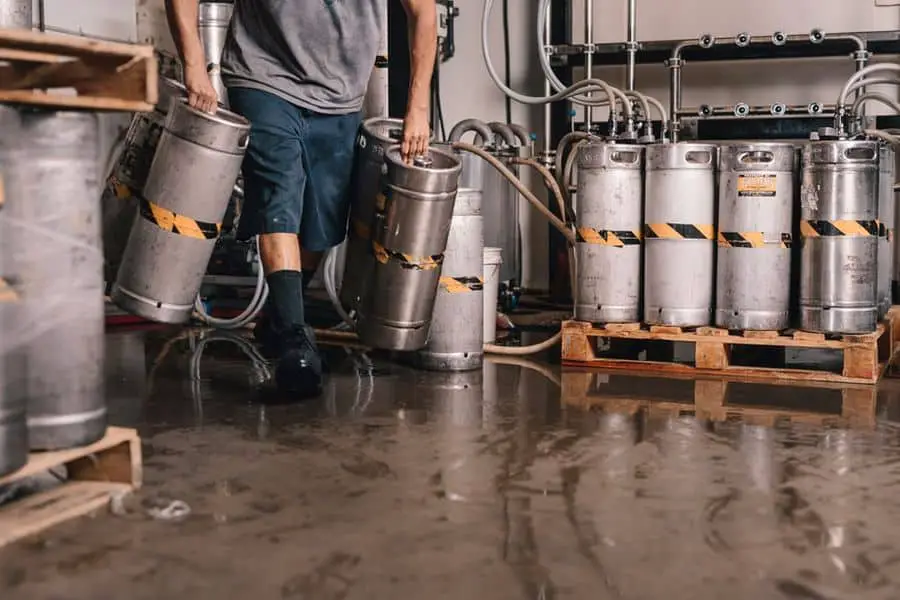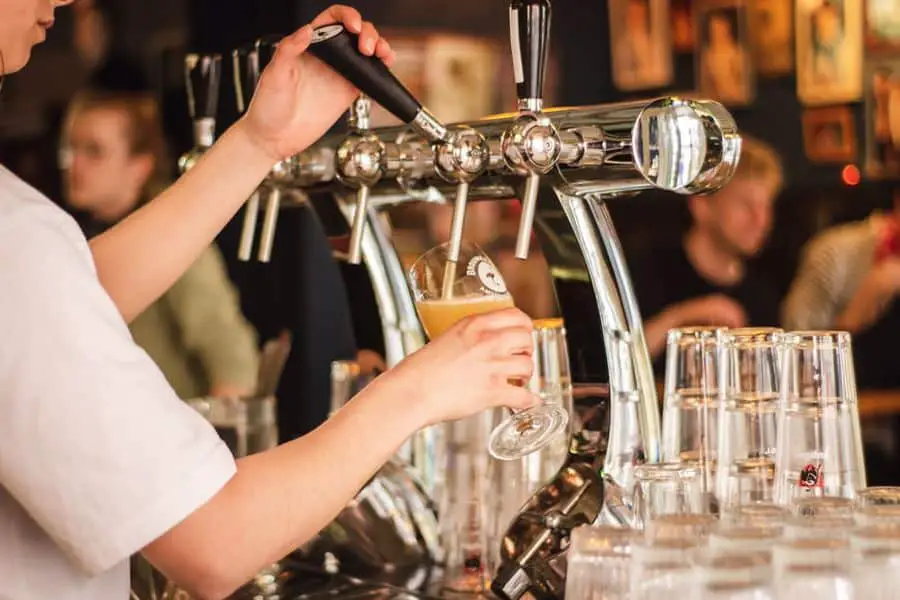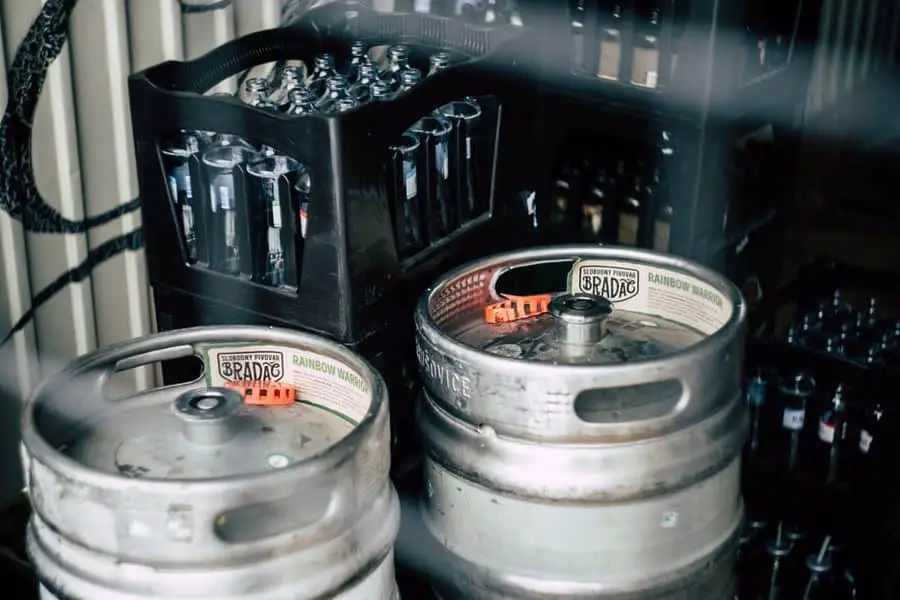If you buy something through a link in our posts, we may get a small share of the sale.
However, knowing how long a keg can last is challenging as it varies with the dispensing system, the style of the beer, and the temperature at which the keg is stored. So, how long does a keg last?
Contents
How Long Does a Keg Last?
If you are dispensing the keg beer with carbon dioxide while maintaining the right pressure and temperature, a keg will last for around 45 to 60 days if it is unpasteurized. If it is pasteurized, a keg will last for around 90 to 120 days. If you are dispensing the keg beer using an air pump, it will remain fresh for around 8 to 12 hours.

Although you may want to enjoy all the beer from your kegerator, not knowing how long your keg can last can mean your beer going bad before you finish it. Let’s talk about different factors that influence how long a keg can stay fresh.
Factors That Affect How Long a Keg Can Last
Although the sell-by-date of a keg is already determined from the day it’s made, other factors affect its shelf life, from the keg dispensing system used to the temperature.
Keg Dispensing System
The type of keg dispensing system you use can significantly impact how long your keg beer will remain fresh. Although different dispensing systems come with varying benefits, some will expose your beer to oxygen than others. Here are some of the beer dispensing systems:
Manual Pump or Party Pump
If you don’t have a kegerator, you can use a party pump to dispense beer. Although a party pump comes with fewer parts and is easier to assemble especially on the go, the beer that has been dispensed using a party pump might not last for long.
Typically, instead of using carbon dioxide to dispense the beer, the manual pump pumps air into the keg and the resulting pressure dispenses the beer. The oxygen pumped in might change the flavor of the beer, and so it is advisable to finish it by the end of the day.
You can also consider buying smaller kegs that you can finish in one tap if you’re planning to use a manual pump. During the dispensing process, try and maintain the right keg temperature to avoid spoiling the beer prematurely.
Jockey Box
The jockey box uses carbon dioxide to pressure and dispense the beer just like a kegerator. The carbon dioxide helps to maintain the beer taste and quality while preventing early beer spoilage.
The jockey boxes come with a specific design for use on the go like a manual pump, only that they use carbon dioxide like the kegerator to maintain the beer flavor and taste.
However, they come with many parts and are a little bit more complicated to assemble than manual pumps. The carbon dioxide used in pressurizing and dispensing the beer helps to prevent oxidation.

Kegerator
The kegerator is the best and most popular beer dispensing system. The kegerator is specifically designed for beer dispensing, ensuring the beer quality and taste are preserved. It comes with a refrigerator storage cabinet which helps to maintain the right temperature for the beer inside the keg.
The ideal temperature ensures you don’t dispense the beer foamy or warm. The carbon dioxide ensures the beer doesn’t come into contact with oxygen, and so the taste and flavor of the beer are maintained.
Typically, a pasteurized beer can last for three to six months if properly stored in a kegerator. However, this duration might vary depending on the beer style. Unpasteurized beers can remain fresh in a kegerator for around two months.
Temperature
Regardless of the beer dispensing system that you are using, maintaining the right temperature for the beer inside the keg can help keep your keg fresh. In most cases, the ideal temperature for storing kegs is 34 to 40 degrees Fahrenheit.
A temperature higher than this can make a beer stale, and also make it excessively foamy when dispensing. A temperature higher than 55 degrees Fahrenheit can lead to bacterial growth in beer which increases the risks of premature spoilage.
On the other hand, a lower temperature can make the beer retain carbonation, which in turn, prevents you from enjoying the aroma and nuanced flavors. Your beer might even freeze if the temperature is less than 28 degrees Fahrenheit.
How Can I Know a Keg Has Gone Bad?
Even after knowing the factors that can affect how long your keg can last, it is important to be able to recognize a keg that has gone bad. Here are some ways you can know that the keg has gone bad.
- Foul taste: If your beer becomes unnaturally sweet or develops a taste like that of a ripe apple or sulfur, it is an indication that the keg has gone bad
- Cloudy appearance: Even before tasting the beer, if it looks excessively foamy or has a cloudy appearance, it is an indication that the keg has gone bad. However, it is normal for the beer to be a little bit foamy especially when you are using a party pump
- Bad smell: In most cases, a spoilt keg will have a bad smell. Just like the taste, the bad smell can be overly sweet or sulfuric.
How Can I Keep My Keg Fresh?
There are some tips you can use to help prolong the shelf life of a keg. Here are some of the tips that can help keep the keg fresh:

- Buy a fresh keg: If you want your keg to have a longer shelf-life, ensure you buy one that is freshly made and not one that is nearing its expiration or sell-by date.
- Store the keg properly: Keep the keg refrigerated in a dark and cold place as both light and heat can damage the alcohol quality in a keg.
- Maintain the right pressure: You will need to maintain the right pressure in your kegerator as high pressure can cause wastage as the beer will gush out when trying to dispense, while low pressure can make the beer flat or excessively foamy. In most cases, the right pressure is around 8-12 PSI.
- Use the correct pump: To prolong the shelf life of your keg, use a pump that uses carbon dioxide to pressure the beer out of the keg. A kegerator is better as it will also maintain the right temperature.
- Consider the type of the beer: The shelf life of the keg will also depend on the type of beer inside. Typically, a beer with a higher alcohol content will last longer
- Consider whether the beer is pasteurized or not: A pasteurized beer will have the damaging microorganisms already treated and will have a longer shelf life than unpasteurized beer.
How Does Oxidation Affect Taste?
For many people, the freshness and taste of the beer start to change after around 20 to 120 days. However, oxidation is the first concept that you should consider.
The keg beer is immediately exposed to oxygen once you tap it, and over time, this oxygen will change the flavor and taste of the beer. If you have a sensitive palate, you might start to notice the change in around one week after tapping it.
Although the flavor of the beer can change due to exposure to oxygen, it doesn’t mean that it is no longer fresh or good for consumption.
Related Questions
Can I Tap a Keg Twice?
If you are using a manual pump, you can only tap a keg once as you’ll be introducing oxygen into the beer. However, if you are using a carbon dioxide pump, you can tap it as many times as you want.
What Is a Keg Made of?
The modern kegs are constructed of metal as they can hold the beer’s flavor better than the wooden barrels. Also, smaller kegs are preferable as they seal the flavor better than the larger kegs.
Final Thoughts
So, how long does a keg last? The shelf life of a keg depends on the storage temperature, pressure, and dispensing system. The type of the beer inside, and whether the beer is pasteurized or not also determines the shelf life of a keg.

